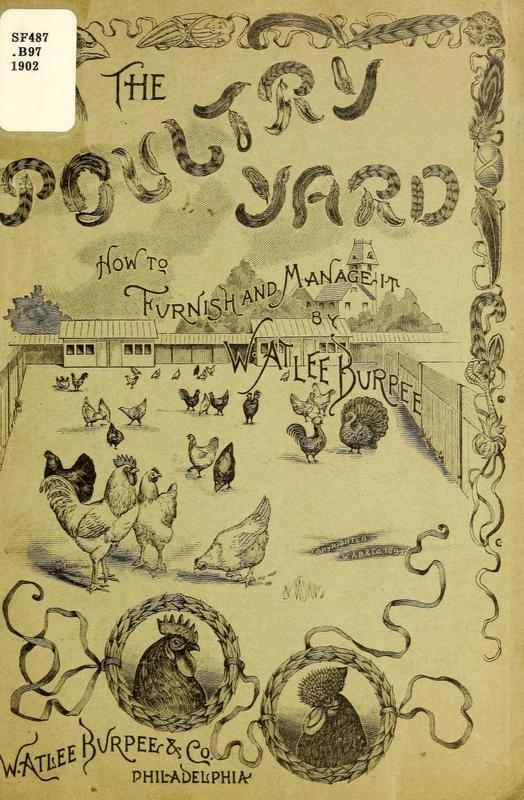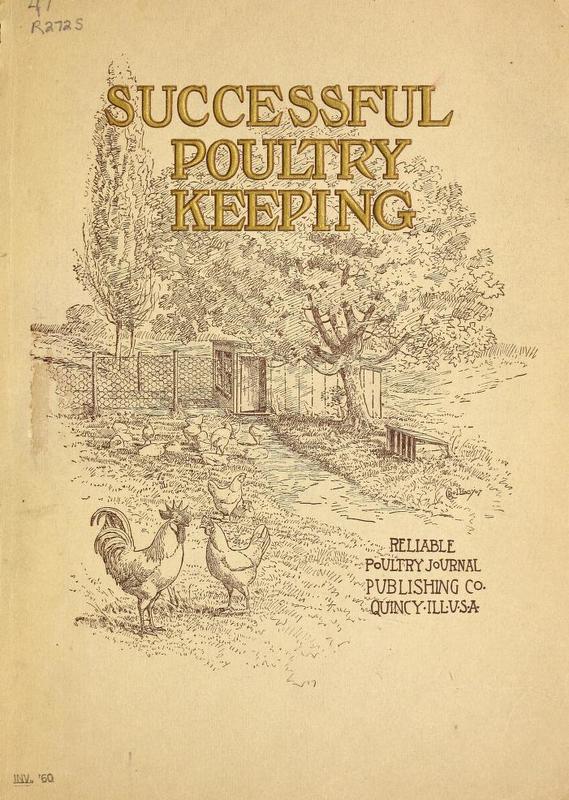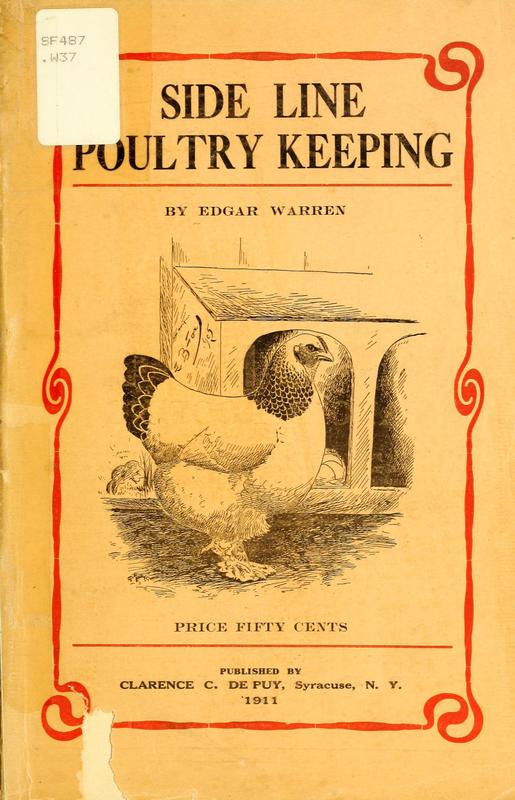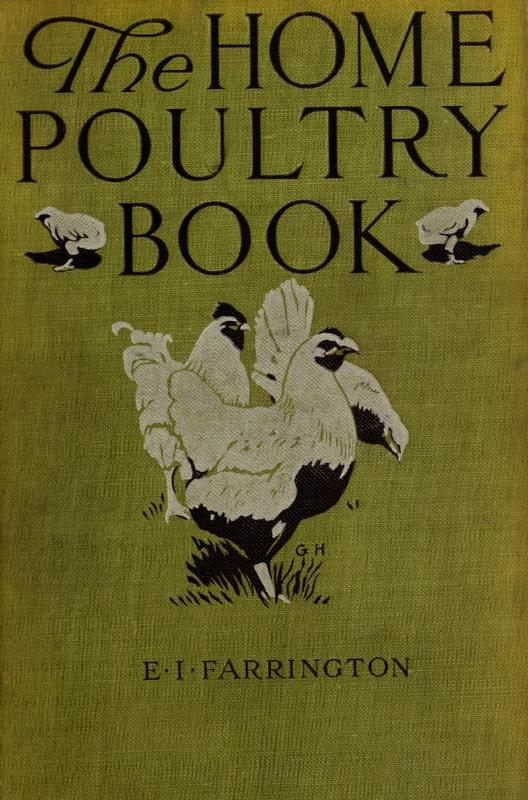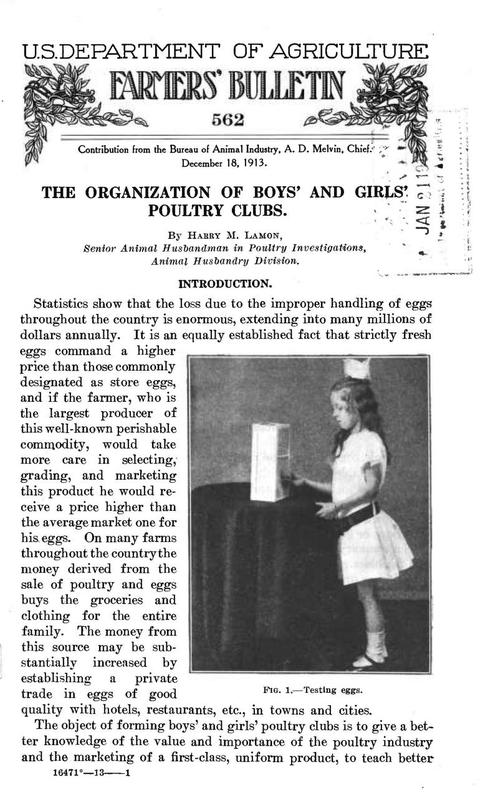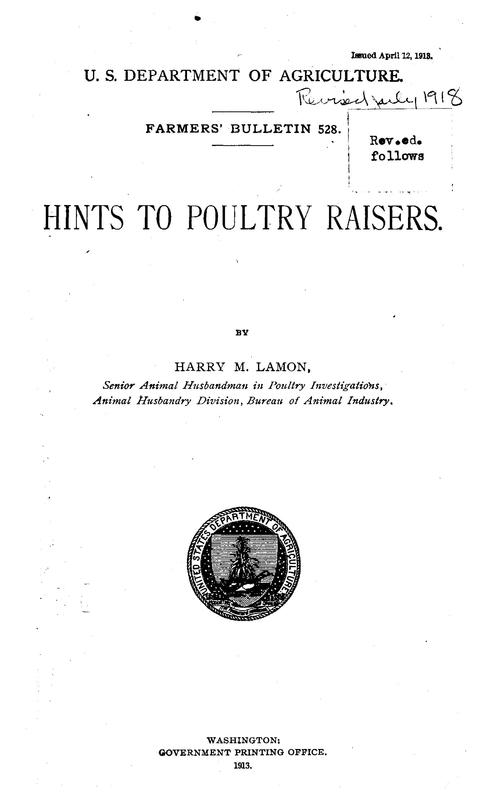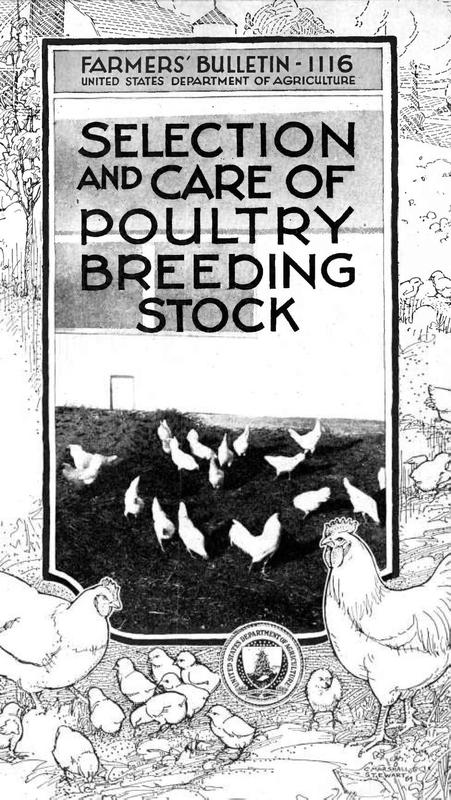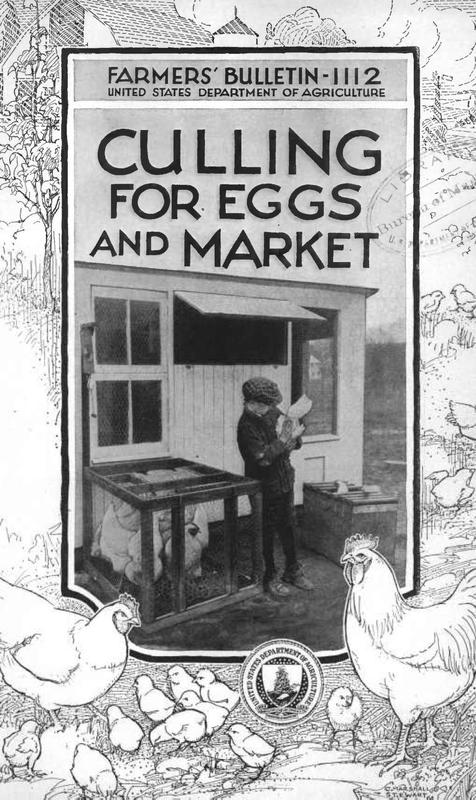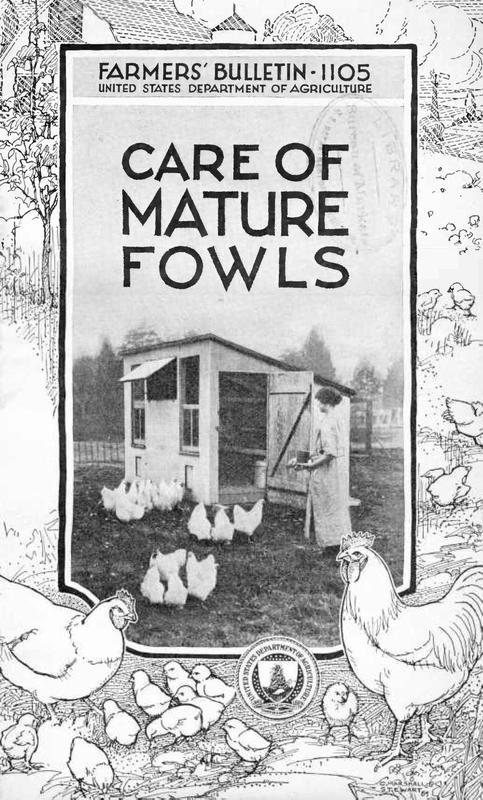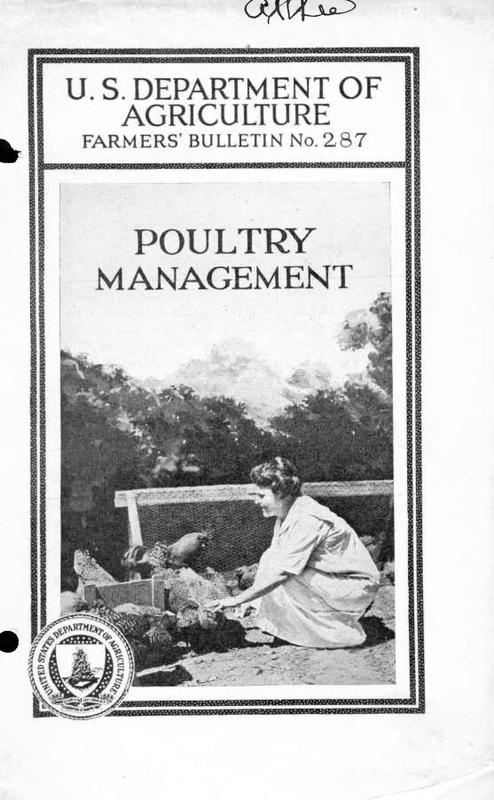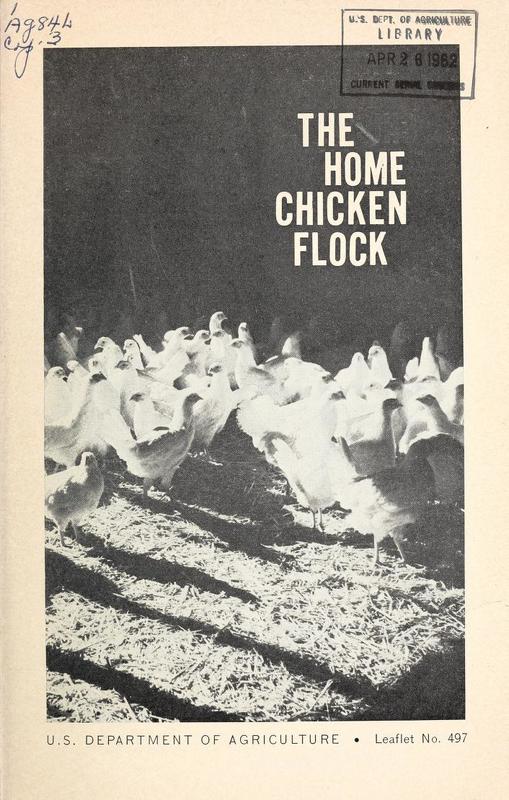Poultry Keeping for the Home Farmer
The Poultry Yard: How To Furnish And Manage It. A Treatise For The Amateur Poultry Breeder And Farmer On The Management of Poultry And The Merits of The Different Breeds
Burpee, Washington Atlee, 1902
"In presenting this edition of the Poultry Yard to our patrons and readers we have endeavored to make a number of valuable additions, especially in the art of caponizing, which is becoming so popular in this country. We have endeavored to discard theory, and present facts derived from the experience of those thoroughly posted. We lay no claims to entire originality in this work. All breeders meet with much the same experience, and it has been our aim to compile from all reliable sources a concise treatise, at a low price, giving instructions to beginners. We have not attempted an elaborate description of the breeds of poultry, only endeavoring to state their respective merits and demerits, and thus enable every amateur to answer for himself the oft-repeated question, "Which breed pays the best?" We would express our indebtedness for valuable hints, especially to The Poultry World, Wright' s Illustrated Book of Poultry, Mr. W. H. Wigmore, and Fancier' 's Journal. We have also introduced in this edition more illustrations and fuller descriptions of the new breeds, information much sought for by hosts of farmers and new fanciers, whose attention is constantly being awakened to the value of improved fowls."
Successful Poultry Keeping: A Text Book for the Beginner and for All Persons Interested in Better Poultry and More of It. Contains the "Secrets of Success" Both for Pleasure and Profit. New and Valuable Information on All Branches of the Poultry Business
Reliable Poultry Journal Publishing Company, 1907
"This book is essentially a compilation of the writings and experiences of many practical, observing business men who are poultrymen first, then fanciers or purveyors to the poultry markets as their several interests dictate. We have endeavored to collect the latest and best reliable information for the beginner with poultry, telling him how to start, what others are doing and have done, the best houses to build, how to manage his flock, in fact we try to show him, in so far as we may, how to become a successful poultry keeper."
Side Line Poultry Keeping : "Two Dollars A Day From Poultry and Eggs"
Warren, Edgar, 1911
"This book is rewritten to meet the needs of those who wish to keep poultry as a side line. So far as the author knows it occupies a field peculiarly its own. Many books have been written about poultry keeping the past few years, and many articles have appeared in the papers on the subject, but the books and articles have been written either to give the general principles underlying poultry culture, to exploit some "system" or to describe some mammoth plant in which the writer or advertiser is interested. The man who wishes to keep hens as a side line, to add a few hundred dollars a year to his income or to reduce family expenses has been neglected.
Side line poultry keeping is destined to assume vast prominence in the future. There are two great movements in progress in the industrial world: the first is the movement to shorten the hours of labor; the second is the tendency of everything we buy to increase in price. The mechanic receives good wages and works short hours, but he can hardly support his family, to say nothing of laying up something for a rainy day. If he is to get ahead, if he is to have a bank account, if he is ever to own a home, he must have some side line to occupy his spare hours and add to his monthly income."
The Home Poultry Book
Farrington, Edward I., 1913
"No doubt the experts whose eyes chance to fall on this book will say that it is elementary. It is, and purposely so. It is designed first and last for the amateur who has no time and inclination to read technical or semi-technical books on poultry keeping. It aims to tell the man with a few hens what to do and how to do it."
The Organization of Boys' and Girls' Poultry Clubs
Lamon, Harry M., 1913
"Statistics show that the loss due to the improper handling of eggs throughout the country is enormous, extending into many millions of dollars annually. It is an equally established fact that strictly fresh eggs command a higher price than those commonly designated as store eggs, and if the farmer, who is the largest producer of this well-known perishable commodity, would take more care in selecting, grading, and marketing this product he would receive a price higher than the average market one for his eggs. On many farms throughout the country the money derived from the sale of poultry and eggs buys the groceries and clothing for the entire family. The money from this source may be substantially increased by establishing a private trade in eggs of good quality with hotels, restaurants, etc., in towns and cities. The object of forming boys' and girls' poultry clubs is to give a better knowledge of the value and importance of the poultry industry and the marketing of a first-class, uniform product, to teach better methods of caring for the poultry and eggs, and to show the increased revenue to be derived from well-bred poultry where proper methods of management are pursued."
Hints to Poultry Raisers
Lamon, Harry M., 1913
"Subscribe for a good poultry paper.
Every poultry keeper should have a copy of the American Standard of Perfection.
Have everything ready beforehand and start your hatching operations early in the year.
A well-ventilated cellar is the best place to operate the incubator.
The machine should be operated according to the manufacturer's directions.
See that the incubator is running steadily at the desired temperature before filling it with eggs. Do not add eggs to a machine during incubation.
Turn the eggs twice daily after the second and through the
eighteenth day. Cool the eggs once daily, according to the weather, from the seventh through the eighteenth day.
Turn the eggs before caring for the lamp.
Attend to the machine carefully at regular hours."
Selection and Care of Poultry Breeding Stock
Slocum, Rob R., 1920
"One of the essentials for success in poultry-club work is good stock. This means standardbred stock; 1 for this stock has been bred and developed for specific purposes and therefore best meets the needs of the boy or girl. A flock of standardbred fowls possesses a uniformity of appearance which the mongrel flock never has, and will arouse the club member's pride and lead to better care.
Moreover, standardbred fowls produce eggs and table carcasses which are much more nearly uniform in size, shape, and color, and which therefore bring better prices. It costs no more to feed and care for standardbred fowls than for mongrels, and there is often an added income possible from them, which may amount to a handsome profit from the sale of breeding stock or eggs for hatching."
Culling for Eggs and Market
Slocum, Rob R., 1920
"Every boy or girl who keeps poultry naturally desires to make as much profit as possible. To do so it is important that every hen kept should be a good layer and that all cockerels except those for breeding purposes (as well as pullets that lack vigor and vitality) should either be eaten or canned for home use or be sold as soon as they are large enough. Selecting or " weeding out " the hens that are poor layers from those that are good layers and picking out for market the cockerels of the flock that are the least likely to develop into good breeders is commonly spoken of as " culling," or culling for eggs and market. If you are to succeed and make money from your poultry it is necessary that you learn to cull your flock accurately so as to keep only such birds as will pay a profit on the feed they eat."
Management of Growing Chicks
Kinghorne, J. W., 1920
"The care of growing chicks, especially during very warm weather, is most important, and every boy or girl who is a member of a poultry club or is raising chickens should give them the best of care at this time if he or she wishes to succeed. The baby chicks may be smart little fellows from strong, vigorous parent stock, and they may have been brooded carefully for the first two or three weeks, but unless they receive proper care and management during their later growing period they will not develop properly, and many of them will be lost by sickness or disease.
ESSENTIALS TO PROPER GROWTH.
The chief essentials to proper growth are good coops or houses, cleanliness, proper feed and water, shade, and free range."
Care of Mature Fowls Lee
Alfred R., 1921
"Poultry-Club members should get good returns from their hens, as a small flock of fowls will give excellent results if they receive the proper feed and care, and the waste from the kitchen, table, and garden will help materially in keeping down the feed bill. The henhouse should be thoroughly cleaned, disinfected, and made tight for the winter. See that the house is tight on three sides and that there is no chance for a draft to strike the hens while on their roosts.
Before putting pullets with old hens be sure that the birds hatched in different years are banded or "toe-punched" so that you can tell the age of each one. Move the pullets into their winter quarters before they begin to lay. All of them should be settled for the winter before the weather gets cold. Market any pullets which are very small, poorly developed, or in poor condition."
Poultry Management
Bell, George A., 1924
"FIRST ATTEMPTS at poultry raising should begin in a small way with a few fowls, and before large investments are made the business should be learned thoroughly. Mistakes will be made and many difficult problems will be presented for solution before any large measure of success will be attained. As soon as the enterprise is found to be profitable, more capital may be put into the plant.
A good plan for one who wishes to learn the art of poultry keeping is to obtain a position with some successful poultryman. One or two years of work on a large, practical plant will be a great help, as the methods of caring for the birds and of marketing the products can thus be learned better than in almost any other way."
The Home Chicken Flock
U.S. Department of Agriculture. Agricultural Research Service. Animal Husbandry Research Division, 1962
 An official website of the United States government.
An official website of the United States government.


